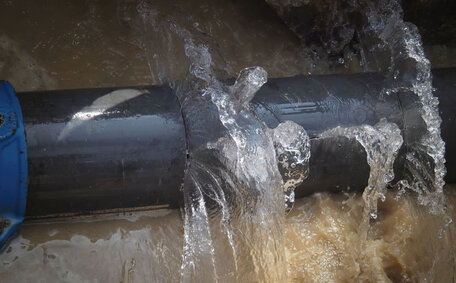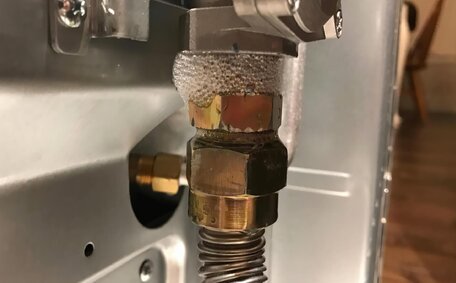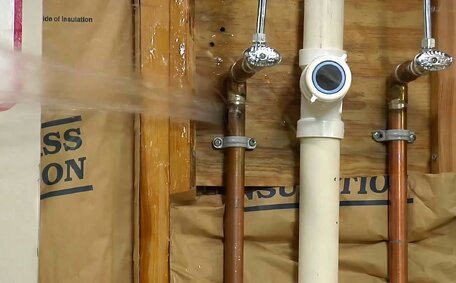Being able to shut off your gas meter is a crucial safety skill for every homeowner and business owner in Randwick, Sydney.
Unexpected gas leaks pose serious risks, including fire, explosion, and carbon monoxide poisoning; swift action to stop the gas flow is essential.
As a trusted, experienced plumbing service in the local area, Randwick Plumbing is here to advise residents and business owners on the proper emergency shut-off procedures to follow for any gas leak that may occur.
This article aims to clearly instruct you on locating your gas meter, turning off appliances safely, and shutting down the gas supply at the primary shut-off point.
We’ll also advise you on post-shutdown procedures like ventilation and when to seek help from a licensed gas fitter.
Prompt, knowledgeable steps during an emergency natural gas incident could significantly tip the balance between life and danger. Our experts want to ensure the Randwick community knows how to respond and stay safe.While professional help should always be called in, understanding these emergency procedures is a simple way homeowners and businesses can protect your property, possessions, and most importantly, your family’s lives.
So, take a moment to read our detailed guide as we walk through the essential steps involved.
Locating the Gas Meter and Main Shutoff Valve
The gas meter and the location of the main shutoff valve are critical and must be easily accessible during a gas leak emergency.
Here are some tips for locating them:
- The gas meter box is typically positioned outside your house or building. It may be on an exterior wall, under an awning, or in a box near ground level. Look for a pipe running into the ground or structure.
- The main shutoff valve, typically a short distance from the gas meter on the pipe, features a handle or switch for operation.
- Ensure that the area around the gas meter and shutoff valves is clear, visible, and accessible.
- Familiarise yourself with the location of your gas meter and associated valves beforehand to save time during an emergency. Regular checks and clear access to these points are essential, and remember, assistance is a call away at the gas leak 1800 427 helpline.
- The main emergency shutoff valve will likely be a quarter-turn ball valve. Turning gas off is achieved by rotating the valve handle until it is 90 degrees perpendicular to the pipe thus ceasing the flow.
- Some valve shall provided inside the building, such as in the garage, utility room, or basement. Check there if you don’t see one outside.
What a Gas Shutoff Valve Looks Like
A gas safety shutoff valve is a critical safety feature found on the incoming gas line to a home or business. Here are some key things to know about identifying and operating one:
- Gas shutoff valves are typically located outdoors, adjacent to the gas meter, and may be ground-level or wall-mounted.
- Common types include quarter-turn ball valves and lever-operated valves. Ball valves have a circular handle that rotates 90 degrees to stop flow gas.
- Valves located are designed to open gas flow with a flat, rectangular nub that the handle fits over when aligned parallel with the pipe for the “on” position.
- Turning the handle so it sits perpendicular to the pipe shuts off gas flow through the valve.
- Valves typically bear a “gas” label and have a yellow handle for easy identification, with an arrow indicating the direction to turn to cut off the gas.
- Underground valves will have a small metal cover at ground level you lift to access the handle beneath.
- Regularly check your valve to confirm a smooth operation and full closure without forcing a stiff mechanism.
Knowing how to identify and operate the shutoff valve can mitigate risks, helping to manage gas leak emergencies swiftly and safely.
Using a Wrench to Turn Off the Gas
When performing an emergency gas shutoff, having the right tools on hand is critical for safety and speed. A gas shutoff often necessitates a wrench to guarantee you can completely engage and close the valve required once the presence of gas is confirmed.
Apply these steps when using a wrench to stop the gas supply:
- Find the gas main shutoff valve on your appliances to ensure proper handling during shut-off procedures. This is usually outside your home or building.
- Keep a designated shutoff wrench near your meter to handle pressure natural gas scenarios, especially after earthquake. A 12-inch (approximately x 450mm) adjustable wrench works well.
- Place the wrench firmly over the valve handle, switching your main incoming gas source off with a quarter turn.
- Double check the valve handle is now crosswise to the pipe in the 'off’ position.
Storing a wrench near your gas shut-off valve means it’s readily available for immediate use in case of a leak.
Never use pliers as they can only damage the valve’s stop button mechanism. Turn the wrench slowly and deliberately - forcing it can damage the valve or pipe connections.
After shutting down the main valve, as a precaution turn off all gas appliances and seek immediate assistance from a licensed gasfitter for inspection.
Turning Off Individual Appliance Valves
After shutting off the main gas supply, it’s equally important to turn off valves for each gas appliance individually in your residence or building.
Gas hot water appliances like heaters, stoves, ovens, and dryers will have their own manual shutoff valves. These allow you to isolate the gas supply to that specific appliance.
Follow these tips for shutting off individual appliance valves during a gas leak emergency:
- Locate the shutoff valve on or near each gas appliance. They are typically behind or underneath the unit.
- Use a wrench to turn the valve a quarter turn until it is perpendicular to the pipe and stops. This cuts off the gas.
- Check appliances pilot like your gas stove and ovens to ensure all burner valves are turned off.
- Double check that pilot lights are also out on appliances like water heaters and furnaces.
- Clearly mark each appliance valve after you shut it off.
Securing individual appliances with their own shutoff valves adds a layer of safety, and these appliance valves should be routinely checked for accessibility and functionality.
Do not attempt to use gas or reactivate the supply on your own; rely on a licensed plumber to conduct leak assessments and safely restore gas service.
Ensuring Proper Ventilation
After performing an emergency gas shut-off, it’s crucial to ensure proper ventilation of the area. Natural gas and LPG can displace oxygen in enclosed spaces, creating a suffocation risk. Here are some tips:
- Open all doors and windows to maximise fresh air circulation.
- Use fans to ventilate if possible, positioning them to blow air out of the building.
- Avoid using any electrical equipment or appliances which could spark an explosion.
- Do not turn on exhaust fans as they may spark from a gas buildup.
- If the gas smell persists, evacuate everyone from the building immediately.
Ensure professional help is sought promptly in the event of natural gas or LPG accumulation, as it poses a risk of carbon monoxide poisoning or explosions. Adequate ventilation and caution are vital after an emergency shut-off; never re-enter a building if gas smells linger.
\ - Open all doors and windows to maximise fresh air circulation.
\ - Use fans to ventilate if possible, positioning them to blow air out of the building.
\ - Avoid using any electrical equipment or appliances which could spark an explosion.
\ - Do not turn on exhaust fans as they may spark from a gas buildup.
\ - If the gas smell persists, evacuate everyone from the building immediately.
\
Checking for Gas Leaks
After shutting off the main gas supply and appliance valves, it’s crucial to thoroughly check for any remaining gas leaks. Undetected leaks can lead to dangerous gas accumulation even after performing an emergency shut-off.
Signs of a gas leak include:
- The distinctive rotten egg smell added to natural gas and LPG.
- An audible hissing noise coming from gas appliances or pipe connections.
- Bubbles forming in standing water, indicating escaping gas.
- Flames coming from pipes or appliance vents.
- Unusual drying or dying vegetation near gas equipment.
To ascertain the source of a gas leak:
- Listen attentively when gas is suspected to be leaking for any hissing sounds that indicate an escape.
- Brush soapy water on the gas pipe - bubbles will appear at any leak sites, or you can also use an approved combustible gas detector if available.
- Employ an approved combustible gas detector when available for precise leak detection.
In the event of a fire emergency where a gas leak is detected, evacuate immediately and call the fire department’s emergency number. Do not enter the premises until cleared by emergency services, as any attempt to tackle a major gas leak could be lethal.
Once the area is secure, contact your local licensed gas fitter to locate the source of leaks and make necessary repairs before restoring service. Never try to turn gas supply back on until all leaks are fixed and inspected by a professional.
After shutting off the main gas supply and appliance valves, it’s crucial to thoroughly check for any remaining gas leaks. Undetected leaks can lead to dangerous gas accumulation even after performing an eme should always be left to qualified professionals. Once you’ve performed an emergency gas shut-off, it’s essential to contact a professional for gas work on your systems right away.
Randwick Plumbing offers seasoned Australian gas professionals, on-call 24/7, for emergency repairs and post-leak inspections.
We have the proper tools and training to:
- Thoroughly inspect your gas system to detect leaks.
- Restore or replace damaged copper pipes, gas valve components, or appliances.
- Test system integrity and relight gas appliances pilot lights once it’s safe to restore gas service.
- Provide official documentation that your system is safe and up to code.
Post-emergency shut-off, refrain from DIY repairs on your gas installations and contact a professional immediately.
Our pros will guarantee your system’s total safety before resuming gas service. To discover more about our emergency services, visit our website or contact Randwick Plumbing at 1300 349 338 or
[email protected] to arrange a time with our licensed gas fitters.
Turning the Gas Back On
Once a licensed professional has completed repairs, you can cautiously restore your gas supply, following the correct safety measures.
First, ensure all gas appliances in the home or building are switched off, and that includes checking the off water valve if applicable. Pilot lights on furnaces, water heaters, stoves and ovens should remain off. All appliance shutoff valves must stay closed initially.
At your houseside main shutoff valve located usually near the gas metre outside, use the appropriate size wrench to gradually turn the valve a quarter turn to align it with the pipe for the open position.
Listen and smell for any indication of lingering gas leaks as you turn the valve, then contact your gas supplier if needed. If a leak is found, turn off the gas immediately and contact your gas company for assistance.
As the main supply is reestablished with no leaks present, progressively reopen appliance shutoff valves, and reignite pilot lights and burners.
Check each appliance carefully for proper operation before moving to the next. Finally, be sure to ventilate the area and never attempt to turn the gas back on yourself after an emergency shutoff.
Preventative Maintenance
Regular preventative maintenance is essential to prevent gas emergencies, ensuring the safe and efficient running of your gas appliances and plumbing system.
Here are some tips for preventative maintenance:
- Ensure all your natural gas appliances receive annual inspections by a licenced gas fitter.
- Check flexible gas connectors for wear and replace them every 5-7 years.
- Look for signs of corrosion, leaks, or damage in pipes and valves.
- Test and clean safety valves on gas water heaters and furnaces.
- Ensure there’s adequate ventilation around appliances, especially around a water heater.
- Clear debris and overgrown plants from your gas metre area.
- Lubricate gas valves that are hard to turn.
- Verify the pilot lights ignite promptly and burn cleanly.
Being proactive with maintenance allows potential issues to be identified and addressed before they become emergencies. Contact the gas safety experts at Randwick Plumbing on 1300 349 338 to schedule inspections and keep your gas systems operating safely.






